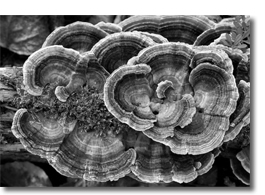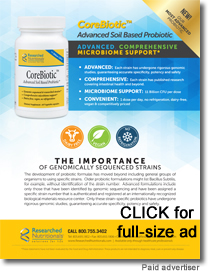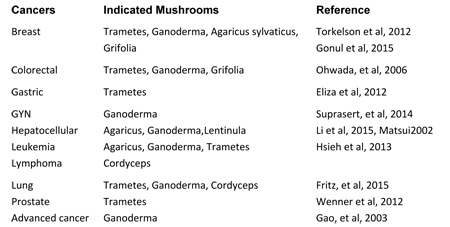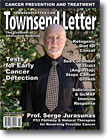|
Page 1, 2
Overview
The healing power of mushrooms has been known for centuries. Having secured a rich history in traditional Chinese medicine, mushrooms have been prescribed and used for many ailments. In this era of healthand wellness, medicinal mushrooms are gaining popularity as a functional food and medicine for their cancer-fighting and cancer-preventing properties. This article reviews the evidence for use of medicinal mushrooms in cancer care. their cancer-fighting and cancer-preventing properties. This article reviews the evidence for use of medicinal mushrooms in cancer care.
The therapeutic uses of medicinal mushrooms are referred to as mycotherapy. Mycotherapy is used in cancer care during surgery, chemotherapy, and radiotherapy to support immune function, as well as following conventional treatments to prevent recurrence. There are several primary mechanisms that have been identified. Research has demonstrated antineoplastic properties, regulation of tumor genes, decrease in tumor angiogenesis, increase in malignant-cell phagocytosis, chemo-sensitization, and protection against chemotherapy-induced bone marrow suppression.
 βeta-glucans βeta-glucans
One of the active compounds responsible for the immune-enhancing effects of mushrooms is in the form of complex polysaccharides known as β -glucans. Glucans can be extracted from cell walls of yeast, oat, barley, seaweeds, algae, and bacteria, as well as fungi. Fungal polysaccharides include chitin, cellulose, β-glucans (e.g. lentinan, grifolan, krestin [PSK]) and a-glucans (e.g. glycogen), or polysaccharide-protein complexes.1 β-glucans are principally found in the fruit body of various types of mushrooms.
Physical and Chemical Properties of β-Glucans
All β-glucans are glucose polymers linked together by a 1→ 3 linear β-glycosidic chain core, and they differ from each other by their length and branching structures.2 Beta glucans can form large cylindrical molecules containing up to 250,000 glucose units. The length and branches of the β-glucan from various fungi are widely different. The immune functions of β-glucans appear to be dependent on their conformational complexity.3 It has been suggested that a higher degree of structural complexity is associated with a more potent immunomodulatory and anti-cancer effect.
Trametes (Coriolus) versicolor: Turkey Tail
Trametes versicolor (formerly called Coriolus versicolor) is one of the most well-studied medicinal mushrooms. The common name "turkey tail" comes from the banding pattern on the fruiting bodies that resembles (in miniature, of course) the tail of a strutting turkey. The colors of the bands can be quite variable, depending on the genetics of the organism and its environment. Most of the bands are dark to light brown in color, alternating with light-colored bands of white to tan, with still more bands of blue, orange, maroon, and other. They can be strikingly beautiful, and are among the most easily found fungi. The species has a widespread distribution, having been found in nearly every state in the United States and in most other countries.
Trametes contains polysaccharide krestin (PSK) and polysaccharide peptide (PSP). These are soluble in water, not ethanol, which addresses the importance of using the proper extraction method for mushrooms. Trametes is the most extensively researched of all medicinal mushrooms with large scale clinical trials on PSK and PSP showing impressive results in a variety of cancers including gastric, esophageal, lung, breast, and colorectal. PSK boosts NK cell production, improves side effects from chemotherapy and radiation therapy, and enhances survival in cancers of the stomach, colon, uterus, and lung in combination with conventional treatment. PSP enhances immune status in patients with cancer of the lung, cervix, ovary, stomach, and esophagus when used as adjuvant to chemotherapy.
In a systematic review and meta-analysis from 13 randomized, placebo-controlled, double blind trials, a significant survival advantage in various cancers was found with Trametes compared with conventional treatment alone. Patients receiving Trametes had a 9% absolute reduction in five-year mortality, resulting in one additional patient alive for every 11 patients treated. Patients with breast, colorectal, and gastric cancer who had been treated with chemotherapy showed the best results in combination with Trametes in five-year survival.4
Seely and colleagues at the Ottawa Integrative Cancer Center published a systematic review in May 2015 of Trametes showing a positive impact on various survival measures in lung cancer.5
While there is not enough evidence to support using Trametes alone for cancer treatment, there is abundant evidence showing its efficacy as adjuvant therapy. Particularly in cases of breast, gynecological, lung, colorectal, and gastric cancer, this mushroom should be a component of the treatment plan, both during and after conventional treatments.
Ganoderma lucidum: Reishi
Ganoderma lucidum, an oriental fungus, has a long history for use for promoting health and longevity in China, Japan, and other Asian countries. It is a large, dark mushroom with a glossy exterior and a woody texture. The Latin word lucidus means "shiny" or "brilliant" and refers to the varnished appearance of the surface of the mushroom.
A Cochrane review of randomized controlled trials using Ganoderma as cancer treatment in all types and stages of cancer was published in 2016.6 Ganoderma in cancer patients had a positive impact on quality of life, as significantly more subjects achieved an increase in performance status after an intervention in the Ganoderma group than in control groups (P < 0.01). The meta-analysis results also reported that patients who had been given Ganoderma with chemo/radiotherapy were 50% more likely to respond positively compared to chemo/radiotherapy alone (P = 0.02).
In a 2003 publication, 30 advanced-stage cancer patients treated with 1800 mg Ganoderma extract three times daily for 12 weeks showed significant increase in NK activity compared to baseline.7 There is not sufficient evidence to justify the use of Ganderma as a first line treatment for cancer. However, Ganoderma administered as an alternative adjunct to conventional treatment is promising, considering its potential to enhance tumor response and stimulate host immunity.
Grifola frondosa: Maitake
Grifola grows in clusters at the base of trees, particularly oaks. Its common name in English is ram’s head or sheep’s head. In a 2009 study, 34 postmenopausal women with stage I, II or III breast cancer, who were free of disease after initial treatment, were given Grifola in escalating doses over three weeks and showed significantly increased NK cell counts compared to baseline.8
Grifola has also been used to prevent postoperative recurrence of bladder cancer. Patients receiving Grifola had a lower recurrence rate than other patients who instead received either BCG, mitomycin C, thiotepa, or placebo.9 It should be noted, however, that prevention of recurrence is only 24% with afterloading brachytherapy.
Lentinula edodes: Shiitake
Lentinula is an edible mushroom native to East Asia, which is cultivated and consumed in many Asian countries. Seven cancer patients undergoing postoperative adjuvant or neoadjuvant chemotherapy for breast or gastrointestinal cancer were given Lentinula 1800mg/day for four weeks. They showed improvement in quality of life and NK cell activity.10
Active hexose correlated compound (AHCC) is a generic term to describe a plant polysaccharide extracted from a liquid culture of basidiomycetous mycelia of Lentinula edodes. AHCC has immune-stimulating activity, anticancer activity, cancer-preventive actions and can prevent side effects during cancer chemotherapy.11 AHCC has also been shown to improve prognosis in post-operative hepatocellular carcinoma patients.12
Inonotus obliquus: Chaga
Inonotus is parasitic on birch and other trees. The conk has the appearance of burnt charcoal, due to massive amounts of melanin. There are no published human trials on Inonotus. Cell studies have shown anti-cancer effects for glioma, melanoma, breast, lung, liver, and colorectal cancer, and in mouse models of sarcoma, lung, stomach, breast and cervical cancer.13
Ophiocordyceps sinensis: Cordyceps
Ophiocordyceps is not a mushroom but a fungus that parasitizes larvae of ghost moths and produces a fruiting body. The fungus germinates in the living larvae, kills, and mummifies it. Once mummified, a stalk-like fruiting body emerges from the corpse. It is known colloquially as caterpillar fungus.
Ophiocordyceps has specifically demonstrated prolonged survival in patients with hepatocellular carcinoma when included in combination with 12 other natural medicines.14
Hericium erinaeus: Lion’s Mane
Hericium is one of the more interesting-looking types of mushrooms. In place of the common mushroom cap is a large clump of spine-like structures a few millimeters long. Hericium has demonstrated anti-cancer potential against human gastrointestinal cancers in cell and mouse models.15
Besides anti-cancer effects, Hericium also exhibits neuro-regenerative effects and may be a reasonable choice for patients during or post-chemotherapy for chemotherapy-induced peripheral neuropathy.16
See Table 1 for a summary of research findings on medicinal mushrooms for various cancers.

Page 1, 2
|
![]()
![]()
![]()
![]()







